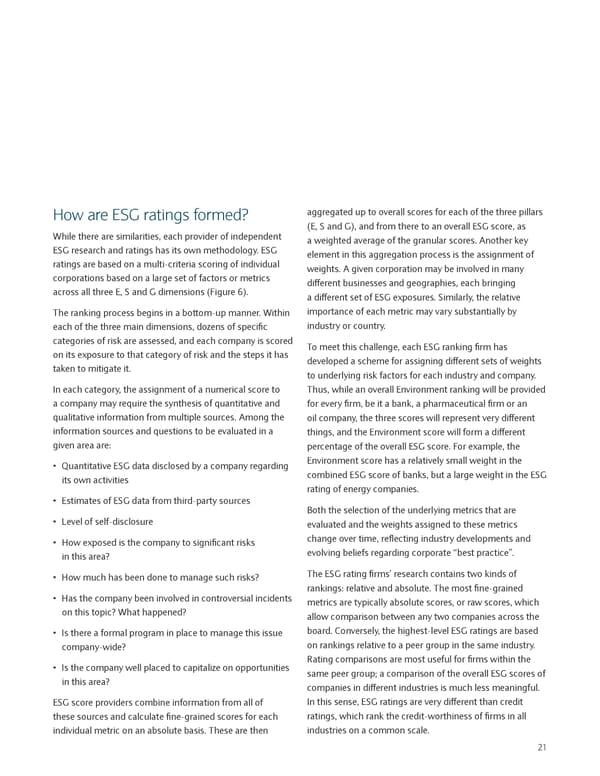How are ESG ratings formed? aggregated up to overall scores for each of the three pillars (E, S and G), and from there to an overall ESG score, as While there are similarities, each provider of independent a weighted average of the granular scores. Another key ESG research and ratings has its own methodology. ESG element in this aggregation process is the assignment of ratings are based on a multi-criteria scoring of individual weights. A given corporation may be involved in many corporations based on a large set of factors or metrics different businesses and geographies, each bringing across all three E, S and G dimensions (Figure 6). a different set of ESG exposures. Similarly, the relative The ranking process begins in a bottom-up manner. Within importance of each metric may vary substantially by each of the three main dimensions, dozens of specific industry or country. categories of risk are assessed, and each company is scored To meet this challenge, each ESG ranking firm has on its exposure to that category of risk and the steps it has developed a scheme for assigning different sets of weights taken to mitigate it. to underlying risk factors for each industry and company. In each category, the assignment of a numerical score to Thus, while an overall Environment ranking will be provided a company may require the synthesis of quantitative and for every firm, be it a bank, a pharmaceutical firm or an qualitative information from multiple sources. Among the oil company, the three scores will represent very different information sources and questions to be evaluated in a things, and the Environment score will form a different given area are: percentage of the overall ESG score. For example, the • Quantitative ESG data disclosed by a company regarding Environment score has a relatively small weight in the its own activities combined ESG score of banks, but a large weight in the ESG rating of energy companies. • Estimates of ESG data from third-party sources Both the selection of the underlying metrics that are • Level of self-disclosure evaluated and the weights assigned to these metrics • How exposed is the company to significant risks change over time, reflecting industry developments and in this area? evolving beliefs regarding corporate “best practice”. • How much has been done to manage such risks? The ESG rating firms’ research contains two kinds of rankings: relative and absolute. The most fine-grained • Has the company been involved in controversial incidents metrics are typically absolute scores, or raw scores, which on this topic? What happened? allow comparison between any two companies across the • Is there a formal program in place to manage this issue board. Conversely, the highest-level ESG ratings are based company-wide? on rankings relative to a peer group in the same industry. • Is the company well placed to capitalize on opportunities Rating comparisons are most useful for firms within the in this area? same peer group; a comparison of the overall ESG scores of companies in different industries is much less meaningful. ESG score providers combine information from all of In this sense, ESG ratings are very different than credit these sources and calculate fine-grained scores for each ratings, which rank the credit-worthiness of firms in all individual metric on an absolute basis. These are then industries on a common scale. 21
 Sustainable Investing and Bond Returns Page 23 Page 25
Sustainable Investing and Bond Returns Page 23 Page 25